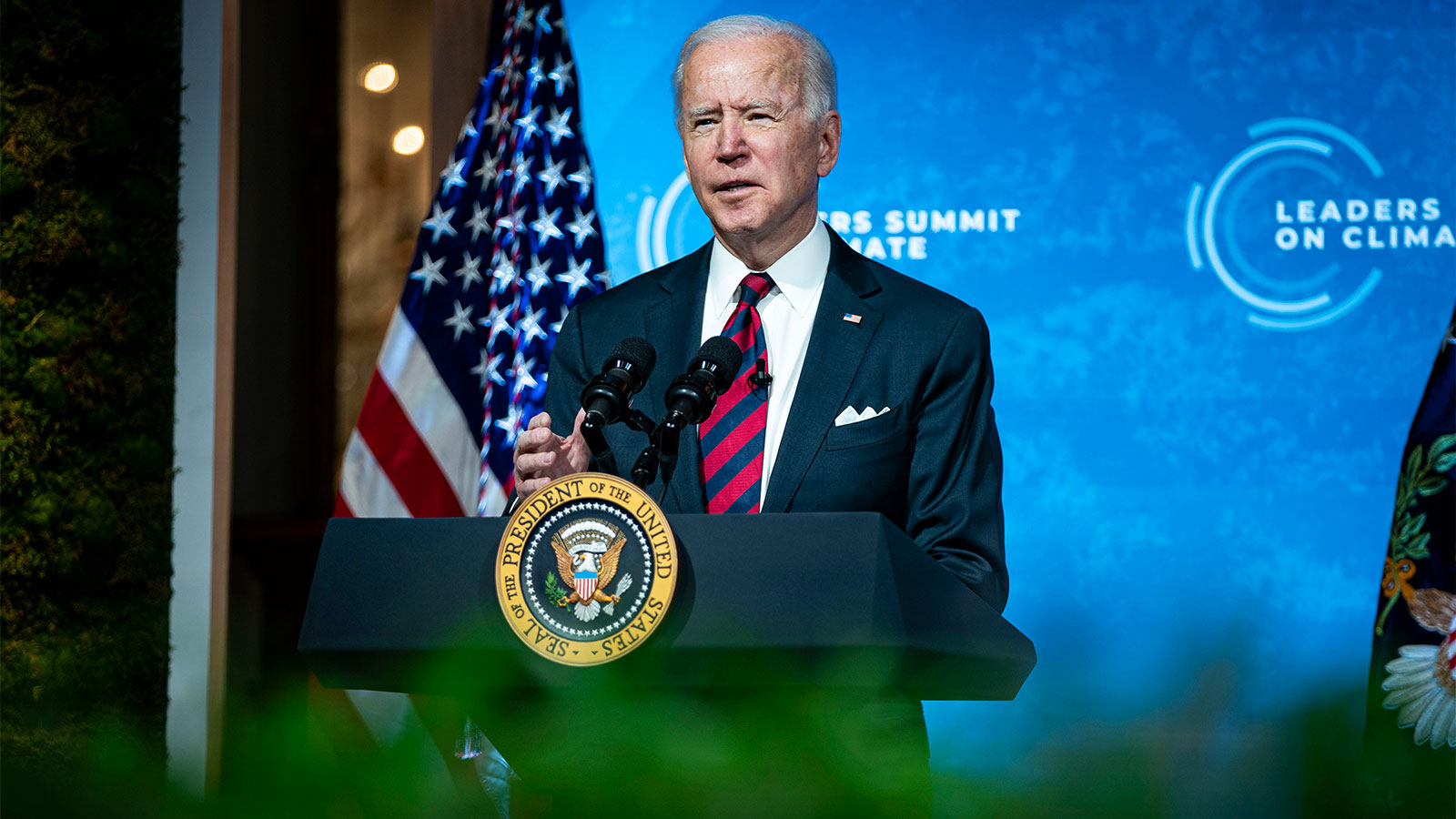In the spring of 2015, nine months before world leaders assembled in Paris to hammer out a landmark agreement on climate change, President Barack Obama quietly announced his pledge to cut carbon emissions. The proposal was relatively modest: a cut in emissions by as much as 28 percent by 2025.
If the U.S. has come close to meeting that goal (by the end of last year, emissions were 21.5 percent below 2005 levels), it was largely by accident. Obama’s plan to cut pollution from the nation’s electricity generation was foiled by Republican backlash and court rulings. Most of the country’s emissions cuts came from the rapid decline of coal and, more recently, the devastation and lockdowns stemming from the coronavirus pandemic.
Now, the country has a new pledge, announced as President Joe Biden gathered 40 world leaders in Washington for a two-day climate summit on Thursday. Biden wants the U.S. to cut greenhouse gas emissions 50 to 52 percent by 2030 — a goal on par with some of the most ambitious in the world. But it’s an open question whether the country can get it done.
The Biden administration’s best hope for meeting that 50 percent reduction target appears to be his $2 trillion infrastructure package — a plan that still has to make its way through both houses of Congress before lawmakers try to pass it through the tangled budget reconciliation process. (It’s already been panned by conservatives as the “Green New Deal in disguise” and “a far left wish list.”) And, as currently envisioned, the package doesn’t include legally binding limits on carbon pollution; instead, it would dole out money to boost clean energy technologies, banking on the fact that emission cuts will naturally follow.
“It’s a little weird to have an ambitious target in a world where there’s not policies that reflect that target,” said Zeke Hausfather, a climate scientist and the director of climate and energy at the environmental think tank Breakthrough Institute. “We hope that things like the infrastructure bill will get us there. But we just don’t know.”
Turning the corner
U.S. energy-related CO2 emissions, million metric tons
Source: Energy Information Administration / InsideClimate News Clayton Aldern / Grist
Over the past two decades, policymakers have slowly come to realize that using a “stick” to cut emissions (such as a carbon tax which puts a penalty on using fossil fuels) is politically unpopular to the point of being — according to one Biden insider — actively dangerous. During its first few months in office, the Biden administration has gone all-in on what is sometimes called “quiet climate policy”: proposing wind and solar farms, 500,000 chargers for electric vehicles, and funding to develop new ways to suck carbon dioxide out of the sky.
The problem is that it’s hard to say whether these interventions will be enough to drastically cut emissions. “The infrastructure plan to me is a downpayment,” said David Popp, a professor of public administration and international affairs at Syracuse University. “By itself, it doesn’t necessarily convince people to change their behavior.” More electric car chargers than gas stations around the country would make it easier for Americans to drive an EV — but they still have to buy one.
“Without the ‘stick’ — without some national level policy that puts a cap on emissions — it’s hard to make a credible case that we’ll definitely be able to follow through” on the 50 percent goal, Popp said.
Biden’s infrastructure package, also known as the “American Jobs Plan,” does include a measure to limit emissions: a “clean energy standard,” that would require the country to get all of its electricity from clean sources by 2035. Hitting Biden’s new target might depend on it. If passed through Congress, the standard could set the country on a path to cut emissions from the power sector by around 80 percent by 2030, and account for almost half of the U.S.’s targeted reductions.
But the clean energy standard might prove tricky to maneuver through Congress. Democrats would need 60 votes to avoid a filibuster — without those votes, they’d be forced to use the arcane budget reconciliation process, which allows bills to be passed with only 50 votes if they’re related to taxing and spending. “It’s not clear that could even qualify as something that could pass under reconciliation,” said Popp.
Some are still optimistic about the U.S.’s chances. After all, policy “sticks” don’t only come from Congress; the president also has power to cut pollution from cars and trucks, or clean up emissions from power plants. A study by the Center for Global Sustainability at the University of Maryland found that the U.S. could cut emissions by 51 percent by 2030, all with actions that could conceivably pass Congress or take only presidential power. That includes boosting incentives for the purchase of electric cars, using the power of the Environmental Protection Agency to impose limits on emissions from coal or gas plants, and increasing energy efficiency in buildings. And that’s not accounting for efforts by states and corporations to curb emissions.
Nathan Hultman, the Center for Global Sustainability’s director and one of the report’s authors, cautioned that it wouldn’t be easy. “You don’t have to assume every possible thing goes right to get to 50,” he said. “But you do have to assume a lot of stuff goes right.”
New EPA emission limits could be short-lived, particularly if a Republican president takes over in 2025. A new administration looking to unravel Biden’s environmental legacy wouldn’t be able to reverse advances in clean energy (or “tear up power lines,” Hausfather said), but he or she could undo rules intended to keep strict limits on emissions, mirroring the Obama-Trump flip-flop. (Trump, on entering office, eviscerated many of the careful regulations the Obama administration had crafted to cut pollution; many of those rules could take years to reinstate.)
Ultimately, just getting close to hitting the 50-percent target might still be OK, as long as the country gets on track to zero out emissions by 2050 in line with Paris agreement goals. International climate pledges are understood to be part performance, less an ironclad promise and more a way of signaling that a country is serious about slashing carbon pollution and wants to convince other big polluters — China, for example, or India and Japan — to do the same.
“What’s important is to reduce emissions as quickly as possible,” said Hausfather. “If we’re at 40 percent below 2005 levels instead of 50 percent it’ll still be a hell of a lot better than where we are today.”



